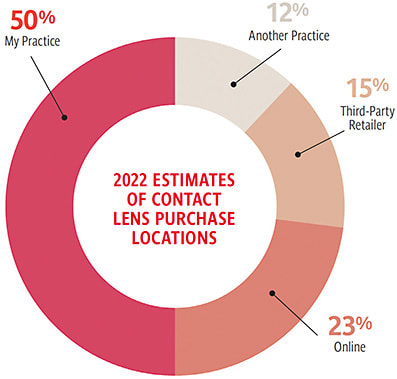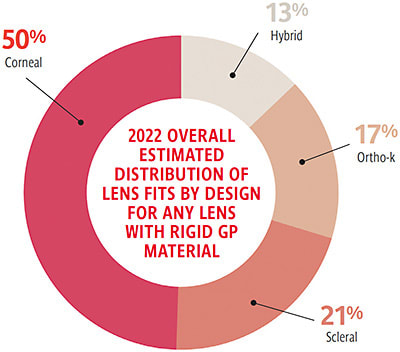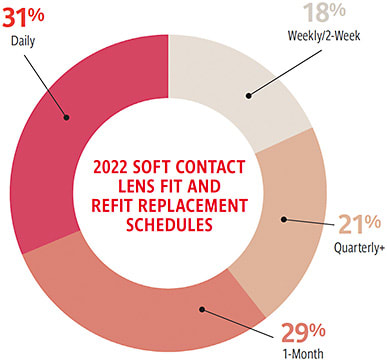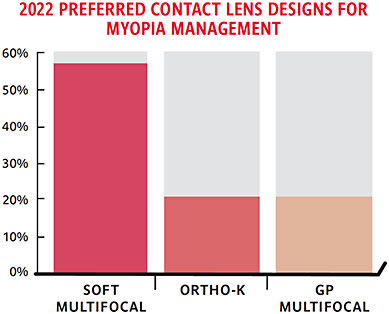
WITH INFECTION RATES slowing significantly over 2020 and 2021 levels around the world and vaccines and treatments firmly in place, is the COVID-19 pandemic effectively over?
While the World Health Organization has not yet officially declared the pandemic over, the organization indicated in September that this classification could come soon. Certainly, the world will now largely live endemically with COVID-19.
COVID changed many ways we go about our lives—telehealth, video conference calls, social distancing, and education to name a few—but also reminded us of the many things that we liked the way they were.
However, while our profession has concerns such as inflation and slow economic growth, we also have a lot to be thankful for—particularly coming out of the pandemic. We have new contact lens designs and materials, new treatments for myopia, and thriving eyecare practices that have survived through the COVID crisis with hard work, determination, and innovation.
OVERVIEW OF GENERAL MARKET TRENDS
Despite several ongoing—and even a few new—challenges in 2022, the soft contact lens market once again proved resilient over the past year. Data obtained from Baird suggests that the global soft contact lens market seems to be on track to grow 8% to 9% through the first nine months of 2022 on a constant currency basis. According to Jeff Johnson, OD, CFA, Baird’s managing director and senior research analyst, this equates to nearly $9.5 billion, a number that is above pre-COVID levels.
The momentum seen across the global soft contact lens market in recent quarters has been driven by several key factors. One has been an ongoing recovery from COVID and, more important, social distancing measures that, even for much of 2021, constrained office visits that are so vital for new contact lens fits. Those new patient headwinds were especially notable in 2021 across several large European markets (where contact lens fittings are often performed in mall-based optical locations) and also in Japan, where COVID recoveries were slower to take hold.
In 2022, however, recoveries in these markets, as well as a strong employment picture and still-solid consumer spending trends for much of the year in the U.S., combined to drive the market’s 8% to 9% constant currency growth. That’s a few points above the 4% to 6% growth that we had come to expect for the global soft contact lens market in the years leading up to COVID. A couple of points of this above-trend growth in 2022 (as of the writing of this article) were also coming from manufacturer price increases, which had been trending one to two points above normal at that point in 2022 due to rising cost inflation, according to Baird.
The real question becomes how defensive soft contact lens market growth might prove over the next 12 to 18 months. That’s especially relevant in the current environment, as macroeconomic headwinds have built in recent months, not just in the U.S., but even more so in Europe. In turn, that creates uncertainty regarding how much discretionary spending will have to shift over the coming year to gas, groceries, mortgage payments, and (especially in Europe) heating costs, and away from products that are otherwise paid for with out-of-pocket dollars (such as contact lenses).
We also remind readers that higher-priced multifocal and toric contact lenses have been big contributors to contact lens market growth over the past decade, suggesting any potential pullback in consumer spending could disproportionally impact uptake of these premium products. According to Baird, daily disposable lenses, in general, also now account for roughly 55% of the global soft contact lens market (by dollars; closer to 30% of the market by wearers), up from ~35% of the market in 2008-2009. This suggests that the risk could be even greater now than even back during the Great Financial Crisis that daily wearers extend the use of their daily lenses to two or three days instead of single-day use, thus reducing reorder demand for contact lenses in the short run.
So, there was undoubtedly some good news in 2022 regarding the pacing of recovery that we’ve seen across the global soft contact lens market in recent quarters. But there are also potential headwinds building. If history is any guide, we believe that contact lenses will weather the storm nicely and the global contact lens market will be much less impacted than many other parts of the economy over the coming year. But time will tell.
CURRENT PRACTICE TRENDS
Contact Lens Spectrum also conducts market research, whereby readers are asked about their practice trends and patterns, both generally and as they relate specifically to contact lenses. We have conducted this market research for many years, which allows for some longer-term and longitudinal analyses.
The questions cover a variety of topics, including characteristics of the patient base of a practice, business and financial aspects of a practice, fitting and prescribing trends, and care solution trends. This year, we had 94 U.S.-based respondents complete the majority of the survey. In proceeding ahead in discussing trends and observations about the contact lens field, I will draw on information provided through this market research, in addition to other sources.
Practice and Business Trends Table 1 summarizes trends in the practice and business characteristics from 2009 to 2022. Most of our respondents were optometrists, followed by ophthalmologists, contact lens technicians, and opticians, respectively. Modes of practice varied, but the most common was solo private practice, followed by group private practice then employee of either an optometrist or ophthalmologist. In 2022, the typical practice averaged seeing 94 patients per week (it was 121 patients per week in 2021). The patient base of the typical practice was made up of approximately 38% contact lens wearers and the average number of contact lens fittings and refittings in a typical week was about 21.
| 2009 | 2010 | 2011 | 2012 | 2013 | 2014 | 2015 | 2016 | 2017 | 2018 | 2019 | 2020 | 2021 | 2022 | |
| Patients Seen Each Week | 108 | 116 | 107 | 127 | 125 | 117 | 124 | 105 | 105 | 109 | 120 | 131 | 121 | 94 |
| % Contact Lens-Wearing Patients | 37 | 36 | 35 | 34 | 34 | 34 | 49 | 33 | 36 | 35 | 35 | 35 | 35 | 38 |
| # CL Fits/Refits per Week | 27 | 27 | 24 | 26 | 25 | 24 | 29 | 26 | 31 | 34 | 25 | 24 | 28 | 21 |
| Estimated % Gross Practice Revenue from CLs | 35 | 34 | 37 | 32 | 30 | 30 | 39 | 32 | 32 | 30 | 31 | 29 | 32 | N/A |
| Estimated % Net Practice Revenue from CLs | 29 | 28 | 26 | 27 | 25 | 25 | 27 | 27 | 27 | 26 | 28 | 23 | 28 | N/A |
Figure 1shows that practitioners estimate that 50% of their patients purchase contact lenses from their practice (61% in 2021), whereas 23% purchase their contact lenses online (23% in 2021), 15% purchase them through a third-party retailer independent of a practice, and 12% purchase their contact lenses from another practice setting.

Further to this, 70% of practitioners believe that they will see an increase in their overall contact lens practice in 2023 (versus 56% for 2022), while 25% believe it will stay the same (versus 39% for 2022), and 5% indicated it will be decreasing further (versus 5% for 2022). This larger-than-expected uptick probably relates to the economic recovery from the pandemic.
Lens Dispensing and Mode of Wear Trends As we have reported in years past, silicone hydrogel materials make up most of the fits and refits that are conducted today, as is shown in Figure 2 (Contact Lens Spectrum market data). In 2011, we noted the first slowing of the silicone hydrogel category, and for 2022, we note that the use of silicone hydrogels is being reported as 43% while hydrogels were reportedly used in 31% of fits in 2022 and GPs were reportedly used across 12% of fits.

As shown in Figure 3, data from Contact Lens Spectrum’s market research showed that across all contact lens designs, most of the reported fits and refits are with soft spherical lenses (30% versus 48% in 2021), followed by soft toric lenses (16% versus 26% in 2021), soft multifocal lenses (12% versus 14% in 2021), spherical corneal GPs (9% versus 4% in 2021), and scleral designs (5% versus 2% in 2021).

Along these same lines, when asked about the greatest growth potential of several popular specialty lens options in 2023, most practitioners indicated orthokeratology (ortho-k) (39% compared to 30% for 2022), followed by scleral lenses (34% compared to 30% for 2022), custom soft lenses (17% compared to 35% for 2022), and hybrids (10% compared to 5% for 2023). Anticipated use within these categories in 2023 is unique this year with the continued drop in anticipated scleral usage and large predicted increase in ortho-k with much greater frequency.
When we asked practitioners to estimate the distribution of lenses by category of lens design for lenses containing any rigid GP lens material (Figure 4), it is perhaps not surprising that corneal designs made up the bulk of fits (50% versus 70% for 2021), followed by sclerals (21% versus 14% for 2021), ortho-k (17% versus 10% for 2021), and hybrids (13% versus 7% for 2021). We see here an interesting shift in fitting trends, with a relatively large downtick for corneal GPs and large upticks for sclerals, ortho-k, and hybrids.

Data obtained from ABB Optical Group (independent optical industry platform) and GfK Retail and Technology (a market research service) showed a similar trend for 2022 when comparing what are considered the four major soft lens categories (spherical, toric, multifocal, and cosmetic). As noted in Table 2, data from these three sources show variability when looking at the soft spherical category (range 36% to 55%) and more consistency with torics and cosmetics.
In addition to the Contact Lens Spectrum Reader Profile Survey (Figure 5), market insights about replacement schedule usage (Table 3) were gleaned from ABB Optical Group and GfK Retail and Technology (Table 3). When comparing the data sources, interesting trends emerge; for all three sources, the daily disposable modality continues to lead in terms of prescribing by soft lens replacement schedule (range of 31% to 52%), followed by the monthly category (range of 29% to 32%).

| SOFT LENS CATEGORY | CONTACT LENS SPECTRUM | ABB OPTICAL GROUP (% SALES) | GfK RETAIL AND TECHNOLOGY (% SALES) | CHANGE FROM 2021 | |
| ABB | GfK | ||||
| Daily | 31% | 52% | 52% | 1.9% | 10% |
| Weekly/Two-Weekly | 18% | 16% | 15% | –0.9% | 1% |
| Monthly | 29% | 33% | 32% | –1.0% | –2% |
| 3 MO+ | 21% | 0% | 0.2% | 0.0% | –6% |
| Note: Columns may not sum to exactly 100% due to rounding. | |||||
As has been the case for several years now, for presbyopic patients wearing contact lenses, most practitioners continue to indicate a preference for multifocal lenses (50% in 2022, compared to 80% in 2021) compared with monovision (26% in 2022, compared to 14% in 2021) and over-spectacles (19% for 2022 and 6% for 2021). This is an unusual trend that may represent a more biased sampling by this year’s respondents.
Myopia management with contact lenses is certainly a growing practice in the contact lens community. In 2022, 75% of Contact Lens Spectrum Reader Profile respondents indicated that they actively practice myopia management with contact lenses (compared with 48% in 2021, 39% in 2020). Of those who are practicing myopia management with contact lenses, most are using a soft multifocal (58%) compared with ortho-k (21%) or corneal GP multifocals (21%) (Figure 6).

YESTERDAY, TODAY, AND TOMORROW
As Maya Angelou once said: “You can’t really know where you are going until you know where you have been.” To that end, each year we look back at the contact lens industry of a decade ago to see what has changed and what remains the same. Additionally, we offer some predictions as to where the industry is heading.
Daily Disposable Contact Lenses In 2012, daily disposable fits and refits were up for the second year in a row and comprised 17% of all fits and refits.1 As noted earlier, daily disposables remain a leader in terms of replacement schedule and have jumped to close to half of all fits, according to several sources. This past year also saw the introduction of several new daily disposable lenses that ranged from standard designs to those tailored to patients who have astigmatism, for use during sports, and to avoid discomfort due to digital device use.
Presbyopia In 2012, for presbyopic patients who were wearing contact lenses, most practitioners indicated a strong preference for multifocal lenses (69%) compared with monovision (19%) and over-spectacles (12%).1 While there has been a slight increase over the past decade, these numbers are not that different from those seen in recent years.
Overall multifocal fits follow the same track. The May 2012 “Editor’s Perspective” noted a growing population in the 45-years-and-older cohort, many of whom would need correction for presbyopia. At that time, multifocal lenses only made up 15% of all fits.2 And while according to this year’s data multifocal fits have increased to 18%, that still leaves a huge pool of potential patients who need this type of correction and not being provided with it.
That said, there has been an uptick in interest in presbyopia overall this past year and new multifocal contact lenses have entered the market. Additionally, on the pharmaceutical side, several “presbyopia drops” are under development, although only one has received U.S. Food and Drug Administration (FDA) approval to date. Going forward, presbyopia will continue to be top of mind over the next year as the British Contact Lens Association (BCLA) announced the release of the BCLA CLEAR Presbyopia papers in January 2024.
Contact Lens and Ocular Safety Back in 2012, we noted a series of articles authored by the FDA that detailed preclinical microbiological testing methodologies and classification for soft lens materials with an expansion to a fifth grouping and related rationale. The steps the FDA was taking to ensure safer contact lens wear for our patients is why that was named the 2012 Event of the Year.
Along similar lines, the FDA once again issued guidance to help contact lens wearers be safe. This past August, the organization issued “Hydrogen Peroxide-Based Contact Lens Care Products: Consumer Labeling Recommendations - Premarket Notification (510(k)) Submissions.”3 The document, which is aimed at manufacturers, comes more than five years after the agency convened its Ophthalmic Devices Panel and its Risk Communication Advisory Committee to discuss how to communicate potential risks of hydrogen peroxide-based contact lens care products. Stakeholder comments, which were due by mid-October, will be incorporated into the final guidance.
Smart Contact Lenses One news item from 2012 seemed as if it were ripped from today’s headlines. Titled “Streaming Video Through a Contact Lens?” the story highlighted an article from the Journal of Micromechanics and Microengineering in which researchers at the University of Washington discussed their long-term goal to create a display that could be comfortably worn in the form of a contact lens. At that time, the display in question consisted of a single controllable pixel, and the researchers noted that significant improvements were necessary to produce fully functional, remotely powered, high-resolution displays.
Flash forward to today, and that idea is almost a reality. In fact, one company recently announced linking a popular online shopping list to its lens display, which would allow shoppers to check items off their lists without having to carry a paper-based list or to consult a hand-held device. That same company has formed partnerships with several sports companies to provide real-time stats from workouts on the lens display as well. While not currently commercially available, this contact lens has been given the breakthrough device designation from the FDA.
Also in 2012, Contact Lens Spectrum included a feature article titled “Ophthalmic Drug Delivery Through Contact Lenses.”4 The author surmised that contact lenses could potentially alleviate several problems associated with delivery of drugs by eye drops. Additionally, the author noted that it may also be possible to achieve improved compliance, particularly for patients who also require contact lenses for vision correction.
In the article, the author mentioned a recently completed phase III study that looked at the release of ketotifen fumarate for allergy treatment as proof of interest in using drug-eluting contact lenses for treating ophthalmic diseases. Again, jump to 2022, and we now have an FDA-approved contact lens that elutes that exact medication.
Currently, there are also several other “smart” lenses being proposed that include various sensors that track and collect data about intraocular pressure, sugar levels (for diabetes management), and more. This is definitely an area that we will see more come to market.
Online Purchases Another area practitioners should keep an eye on is online retail opportunities and hurdles. On one side of this are the online-only retailers, which includes both resellers of contact lenses from multiple companies and consumer-facing private-label manufacturers. There has been much debate among practitioners and these retailers, especially as their practices relate to the Contact Lens Rule of the Federal Trade Commission (FTC).
The rule went into effect in October 2020, with implementation delayed until March 2021. Since then, according to this past March’s “Editor’s Perspective,” many practitioners continue to voice concern about the “burdensome nature” of the Rule.5 Of particular concern was the ability for sellers to substitute contact lenses for “private-label lenses” if “the substitute lenses are made by the same manufacturer and are identical to the prescribed lenses.” However, research and clinical experience has shown that even lenses with the same parameters are not identical from one manufacturer to another.6,7
Additionally, the Department of Justice and the FTC issued a decision this past year that directed one online reseller to make substantial payments to consumers who bought their private-label lenses. The FTC alleged that the company substituted its own brand of lenses for those prescribed by the consumers’ eyecare practitioners in violation of the Contact Lens Rule and violated the FTC Act by deceiving consumers about whether their practitioners had approved the substitution, among other things.8 This bodes well for practitioners going forward, as it sends a strong message to other resellers that questionable practices won’t be tolerated. For these reasons, we have named this decision as the Contact Lens Event of the Year.
On the other side of the online retail issue is whether practitioners should institute their own online “shops.” Over the years, many eyecare providers have been cautious about incorporating online ordering for fear of losing sales to stand-alone online retailers. And while there have been a number of online ordering systems around for quite some time now, many practitioners were forced to look more closely at their ordering software options to help with contact lens capture rates during the height of the COVID-19 pandemic.9 This trend is sure to continue over the next few years. CLS
REFERENCES
- Nichols JJ. Contact Lenses 2012. Contact Lens Spectrum. 2013 Jan;28:24-29,52.
- Nichols JJ. Presbyopes May Be Key in Growing the Market. Contact Lens Spectrum. 2012 May;27:13.
- U.S. Food and Drug Administration. Hydrogen Peroxide-Based Contact Lens Care Products: Consumer Labeling Recommendations – Premarket Notification (510(k)) Submission. 2022 Aug 17. Available at fda.gov/media/160909/download . Accessed Nov. 30, 2022.
- Chauhan A. Ophthalmic Drug Delivery Through Contact Lenses. Contact Lens Spectrum. 2012 Nov;27:23-29.
- Nichols JJ. A Stickler for the Rule. Contact Lens Spectrum. 2022 Mar;37:8.
- van der Worp E, Lampa M, Kinoshita B, Fujimoto MJ, Coldrick BJ, Caroline P. Variation in sag values in daily disposable, reusable and toric soft contact lenses. Cont Lens Anterior Eye. 2021 Dec;44:101386.
- Brujic M, Kading DL. Are All Soft Contact Lenses the Same? Contact Lens Spectrum. 2022 Nov;37:48.
- Federal Trade Commission. Vision Path, Inc., Online Seller of Hubble Lenses, Settles Charges It Violated the Contact Lens Rule and FTC Act to Boost Sales. 2022 Jan 28. Available at ftc.gov/news-events/press-releases/2022/01/vision-path-inc-online-seller-hubble-lenses-settles-charges-it . Accessed Nov. 30, 2022.
- Brujic M, Kading DL. Is Online Contact Lens Ordering the New Normal? Contact Lens Spectrum. 2022 Sep;37:50.



